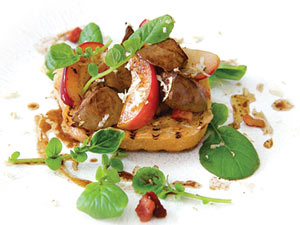October 2010
A local chef brings a dash of hip to an unlikely traditional cuisine. Welcome to the new “Shaker Gourmet.”
by Judith Gaines
 You have to take off your halo-like bonnet to anyone who wants to celebrate Shaker cuisine. One of the sect’s most avid cooks, Eldress Bertha Lindsay, once described their food as “plain country cooking.” Others have called it “nutritious and wholesome.” Try: borrrrrring.
You have to take off your halo-like bonnet to anyone who wants to celebrate Shaker cuisine. One of the sect’s most avid cooks, Eldress Bertha Lindsay, once described their food as “plain country cooking.” Others have called it “nutritious and wholesome.” Try: borrrrrring.
The only three surviving Shakers live at Sabbathday Lake off Route 26 west of Gray, and with their practice of celibacy, the future doesn’t look great–food-wise or anywise.
But Chef Sebastian Carosi thinks their culinary strengths have been overlooked and may be coming back in style. A few years ago, during his time heading culinary operations at Canterbury Shaker Village (operated exclusively as a museum since its last resident passed in 1992) in New Hampshire, he sifted through scores of old recipes. “I was wowed by their commitment to sustainable, organic ingredients,” he says. “They only used what they grew, and they used everything they raised. They even used pigs’ blood to make pastries and made gelatin from pigs’ feet.”
Modern locavores might be intrigued to discover how some “found foods” on Shaker property make their way into meals. “The Shakers stew cattails, sautée milkweed pods, and put nettles in their soups,” Carosi says. “‘Coffee’ is a brew of barley, peas, roasted carrots, and the root of an herb called avens.”
Although their food is fairly simple, “they believe in keeping up with the times,” he says. So Carosi, who lives in Kennebunk and heads the New England Farm 2 Fork Project, is “bringing Shaker food into 2010” with a series of meals and workshops at private farms and Shaker sites around the region.
At a recent dinner held at the Raven Hill Orchard Farm in East Waterboro, 26 attendees gathered in the barn’s post-and-beam loft, the mood set by tea lights in Mason jars and vases of local wildflowers on rustic tables. After nibbles of local cheese–the Shakers make their own, probably Colby or farmhouse cheddar–the meal began with “crispy-fried, local, buttermilk-soaked, barnyard chicken livers on toast with oak-aged black vinegar cream, young rocket, and pickled heirloom orchard apples,” Carosi says. These dishes “are inspired by the Shaker philosophy of frugality and their good sense in pickling what they have a lot of. And they have a lot of apple trees, about 1,900 at Sabbathday Lake.”
Next came “country-fried American Bourbon Red Turkey,” in keeping with the Shakers’ interest in heritage breeds. This was served with “pickled mustard greens and creamed corn misaquatash,” somewhat like a Shaker dish of steamed beans and corn in cream, but Carosi gussied it up with fresh chives, parsley, and green onions. The salad was “the freshest mess of field greens, herbs, and flowers, with a switchel vinaigrette and smoked trout.” Switchel, he explains, is a refreshing drink the Shakers love, especially during haying season: a mix of vinegar and ice water with ginger, molasses, and maple syrup.
Roasted “Sabbathday Lake herb-rubbed Berkshire pork tenderloin” was served with bacon-fat spinach, chou chou, and smoked hamhock-stewed heirloom Maine white beans”–dishes based not on particular Shaker recipes but on their philosophy and style, described by Carosi as “embracing ingredients that are whole, pure, best-raised, carefully tended, and heartily presented. They wouldn’t want any skimpy dishes on the table.”
Entrees were accompanied by squash rolls, which the Shakers make with canned pumpkin, as did Carosi. Everything was washed down with “Shaker-spiced Concord grape drink,” made with lemon peel, cinnamon sticks, cloves, allspice berries, sugar, water, and Concord grape juice. Dessert was traditional spiced applesauce cake.
Like most of the participants, Lisa Rancourt, 41, of Saco, says she didn’t know anything about Shaker cooking before she went to the dinner. “I never heard of Switchel or chou chou or half the things on the menu. I just know they tasted damn good…And I got a little history lesson about the Shakers.”
That, more or less, is Carosi’s goal. “I don’t want what the Shakers do to be lost.”
Asked about interest in Shakers and their food ways, Brother Arnold, one of the remaining members of the sect, says he hopes it brings more tourism. And interest is on the uptick. Mother Ann Lee, who founded the American sect in 1774, said there would come a time when the number of Shakers “could be counted on one hand,” and then there would be a revival of popular interest in them.
“There you have it,” Brother Arnold says.
>> Join Carosi’s dinners: thenewenglandfarm2forkproject.com.





0 Comments